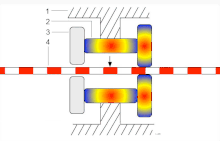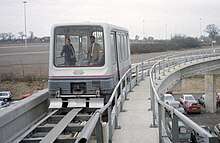Linear motor

A linear motor is an electric motor that has had its stator and rotor "unrolled", thus, instead of producing a torque (rotation), it produces a linear force along its length. However, linear motors are not necessarily straight. Characteristically, a linear motor's active section has ends, whereas more conventional motors are arranged as a continuous loop.
A typical mode of operation is as a Lorentz-type actuator, in which the applied force is linearly proportional to the current and the magnetic field .
Linear motors are most commonly found in high accuracy engineering[1] applications.
Many designs have been put forward for linear motors, falling into two major categories, low-acceleration and high-acceleration linear motors. Low-acceleration linear motors are suitable for
High-acceleration linear motors are typically used in studies of
Types
Brushless
Brushless linear motors are members of the Synchronous motor family. They are typically used in standard
Brush
Synchronous
In this design the rate of movement of the magnetic field is controlled, usually electronically, to track the motion of the rotor. For cost reasons synchronous linear motors rarely use commutators, so the rotor often contains permanent magnets, or soft iron. Examples include coilguns and the motors used on some maglev systems, as well as many other linear motors. In high precision industrial automation linear motors are typically configured with a magnet stator and a moving coil. A Hall effect sensor is attached to the rotor to track the magnetic flux of the stator. The electric current is typically provided from a stationary servo drive to the moving coil by a moving cable inside a cable carrier.
Induction

In this design, the force is produced by a moving linear magnetic field acting on conductors in the field. Any conductor, be it a loop, a coil or simply a piece of plate metal, that is placed in this field will have eddy currents induced in it thus creating an opposing magnetic field, in accordance with Lenz's law.[4] The two opposing fields will repel each other, thus creating motion as the magnetic field sweeps through the metal.
Homopolar

In this design a large current is passed through a metal sabot across sliding contacts that are fed by two rails. The magnetic field this generates causes the metal to be projected along the rails.
Tubular
Efficient and compact design applicable to the replacement of pneumatic cylinders.
Piezoelectric

Piezoelectric drive is often used to drive small linear motors.
History
Low acceleration
The history of linear electric motors can be traced back at least as far as the 1840s, to the work of
In a single sided version the magnetic repulsion forces the conductor away from the stator, levitating it, and carrying it along in the direction of the moving magnetic field. He called the later versions of it magnetic river. The technologies would later be applied, in the 1984, Air-Rail Link shuttle, between Birmingham's airport and an adjacent train station.

Because of these properties, linear motors are often used in
Similar technology is also used in some roller coasters with modifications but, at present, is still impractical on street running trams, although this, in theory, could be done by burying it in a slotted conduit.
Outside of public transportation, vertical linear motors have been proposed as lifting mechanisms in deep

High acceleration
High-acceleration linear motors have been suggested for a number of uses. They have been considered for use as
The United States Navy is also using linear induction motors in the
High-acceleration linear motors are difficult to design for a number of reasons. They require large amounts of
Two different basic designs have been invented for high-acceleration linear motors: railguns and coilguns.
Usage
Linear motors are commonly used for actuating high performance industrial automation equipment. Their advantage, unlike any other commonly used actuator, such as a ball screw, timing belt, or rack and pinion, is that they provide any combination of high precision, high velocity, high force and long travel.
Linear motors are widely used. One of the major uses of linear motors is for propelling the shuttle in looms.
Linear motors have been used for sliding doors and various similar actuators. They have been used for baggage handling and even large-scale bulk materials transport.
Linear motors are sometimes used to create rotary motion. For example, they have been used at observatories to deal with the large radius of curvature.
Linear motors may also be used as an alternative to conventional chain-run lift hills for roller coasters. The coaster Maverick at Cedar Point uses one such linear motor in place of a chain lift.
A linear motor has been used to accelerate cars for crash tests.[9]
Industrial automation
The combination of high precision, high velocity, high force, and long travel makes brushless linear motors attractive for driving industrial automations equipment. They serve industries and applications such as semiconductor steppers, electronics surface-mount technology, automotive cartesian coordinate robots, aerospace chemical milling, optics electron microscope, healthcare laboratory automation, food and beverage pick and place.
Machine tools
Synchronous linear motor actuators, used in machine tools, provide high force, high velocity, high precision and high dynamic stiffness, resulting in high smoothness of motion and low settling time. They may reach velocities of 2 m/s and micron-level accuracies, with short cycle times and a smooth surface finish.[10]
Train propulsion
Conventional rails
All of the following applications are in rapid transit and have the active part of the motor in the cars.[11][12]
Bombardier Innovia Metro
Originally developed in the late 1970s by
- Line 3 Scarborough in Toronto (opened 1985; closed 2023)[13]
- Vancouver SkyTrain(opened 1985 and extended in 1994)
- Detroit People Mover in Detroit (opened 1987)
ICTS was sold to
- Kelana Jaya Linein Kuala Lumpur (opened 1998 and extended in 2016)
- Millennium Line of the Vancouver SkyTrain (opened 2002 and extended in 2016)
- AirTrain JFK in New York (opened 2003)
- Airport Express (Beijing Subway)(opened 2008)
- Everlinein Yongin, South Korea (opened 2013)
All Innovia Metro systems use third rail electrification.
Japanese Linear Metro
One of the biggest challenges faced by Japanese railway engineers in the 1970s to the 1980s was the ever increasing construction costs of subways. In response, the Japan Subway Association began studying on the feasibility of the "mini-metro" for meeting urban traffic demand in 1979. In 1981, the Japan Railway Engineering Association studied on the use of
To date, the following subway lines in Japan use linear motors and use overhead lines for power collection:
- Two Osaka Metro lines in Osaka:
- Nagahori Tsurumi-ryokuchi Line (opened 1990)
- Imazatosuji Line (opened 2006)
- Toei Ōedo Line in Tokyo (opened 2000)
- Kaigan Line of the Kobe Municipal Subway (opened 2001)
- Nanakuma Line of the Fukuoka City Subway (opened 2005)
- Yokohama Municipal Subway Green Line (opened 2008)
- Sendai Subway Tōzai Line (opened 2015)
In addition, Kawasaki Heavy Industries has also exported the Linear Metro to the Guangzhou Metro in China;[15] all of the Linear Metro lines in Guangzhou use third rail electrification:
Monorail
This article needs additional citations for verification. (July 2009) |
- There is at least one known monorail system which is not magnetically levitated, but nonetheless uses linear motors. This is the Moscow Monorail. Originally, traditional motors and wheels were to be used. However, it was discovered during test runs that the proposed motors and wheels would fail to provide adequate traction under some conditions, for example, when ice appeared on the rail. Hence, wheels are still used, but the trains use linear motors to accelerate and slow down. This is possibly the only use of such a combination, due to the lack of such requirements for other train systems.
- The TELMAGVis a prototype of a monorail system that is also not magnetically levitated but uses linear motors.
Magnetic levitation

- High-speed trains:
- Shanghai(opened in 2004)
- SCMaglev, under construction in Japan (fastest train in the world, planned to open by 2027)
- Rapid transit:
- Birmingham Airport, UK (opened 1984, closed 1995)
- M-Bahn in Berlin, Germany (opened in 1989, closed in 1991)
- Daejeon EXPO, Korea (ran only 1993)[16]
- HSST: Linimo line in Aichi Prefecture, Japan (opened 2005)
- Incheon Airport Maglev (opened July 2014)
- Changsha Maglev Express (opened 2016)
- S1 line of Beijing Subway(opened 2017)
Amusement rides
There are many roller coasters throughout the world that use LIMs to accelerate the ride vehicles. The first being Flight of Fear at Kings Island and Kings Dominion, both opening in 1996. Battlestar Galactica: Human VS Cylon & Revenge of the Mummy at Universal Studios Singapore opened in 2010. They both use LIMs to accelerate from certain point in the rides.
Revenge of the Mummy also located at Universal Studios Hollywood and Universal Studios Florida. The Incredible Hulk Coaster and VelociCoaster at Universal Islands of Adventure also use linear motors. At Walt Disney World, Rock 'n' Roller Coaster Starring Aerosmith at Disney's Hollywood Studios and Guardians of the Galaxy: Cosmic Rewind at Epcot both use LSM to launch their ride vehicles into their indoor ride enclosures.
In 2023 a
Aircraft launching
Proposed and research
- Launch loop – A proposed system for launching vehicles into space using a linear motor powered loop
- StarTram – Concept for a linear motor on extreme scale
- Tether cable catapult system
- Aérotrain S44 – A suburban commuter hovertrain prototype
- Research Test Vehicle 31– A hovercraft-type vehicle guided by a track
- Hyperloop – a conceptual high-speed transportation system put forward by entrepreneur Elon Musk
- Elevator "ThyssenKrupp Elevator: ThyssenKrupp develops the world's first rope-free elevator system to enable the building industry face the challenges of global urbanization". Archived from the original on 2016-03-03. Retrieved 2015-06-02.
- Lift "Technology: Linear Synchronous Motor Elevators Become a Reality". Archived from the original on 2015-03-30. Retrieved 2015-06-02.
- Magway - a UK freight delivery system under research and development that aims to deliver goods in pods via 90 cm diameter pipework under and over ground.
See also
- Linear actuator
- Linear induction motor
- Linear motion
- Maglev
- Online Electric Vehicle
- Reciprocating electric motor
- Sawyer motor
- Tubular linear motor
References
- ^ "Linear Motors". engineering.com. Retrieved 2020-09-15.
- ^ "inear motors come into their own". DesignNews. May 18, 1998.
- ^ Collins, Danielle (March 15, 2019). "Are brushed motors suitable for industrial applications?".
{{cite journal}}: Cite journal requires|journal=(help) - doi:10.13140/RG.2.2.16250.18887. Retrieved 24 December 2017.)
{{cite journal}}: Cite journal requires|journal=(help - ^ "Charles Wheatstone - College History - King's College London". Kcl.ac.uk. Archived from the original on 2009-10-21. Retrieved 2010-03-01.
- ^ "CEM - Fall/Winter 1997 Issue - Germany's Transrapid". Archived from the original on 2011-09-28. Retrieved 2011-08-24.
- ^ "Magnetic Materials - Electromagnetic Guns". coilgun.info. Archived from the original on 2008-05-16. Retrieved 2014-11-22.
- S2CID 119243251.
- ISSN 0161-7370.
- ^ "machine tools turn linear motors". DesignNews. September 20, 1999.
- ^ "Adoption of Linear Motor Propulsion System for Subway". Home.inet-osaka.or.jp. Archived from the original on 2017-08-06. Retrieved 2010-03-01.
- ^ "Linear motor". Archived from the original on July 8, 2008.
- ^ "The Scarborough Rapid Transit Line – Transit Toronto – Content". Transit Toronto. November 10, 2006. Retrieved 2010-03-01.
- ^ "History of Linear Metro promotion". Japan Subway Association.
- ^ "> Asia > China > Guangzhou Metro". UrbanRail.Net. Archived from the original on 2010-03-02. Retrieved 2010-03-01.
- ^ "The International Maglevboard". Maglev.de. Retrieved 2010-03-01.
External links
- Design equations, spreadsheet, and drawings
- Motor torque calculation
- Overview of Electromagnetic Guns

